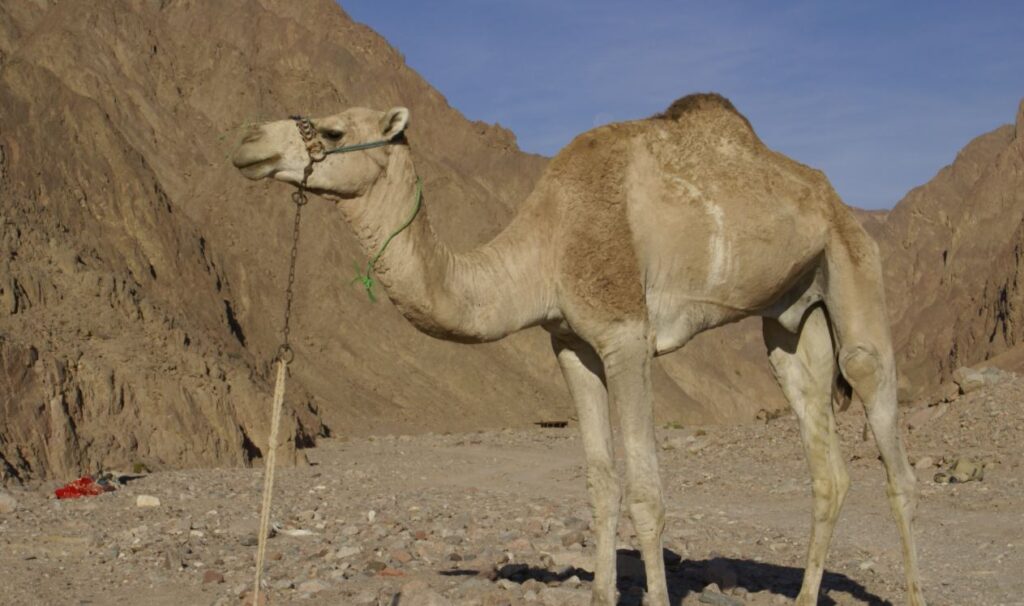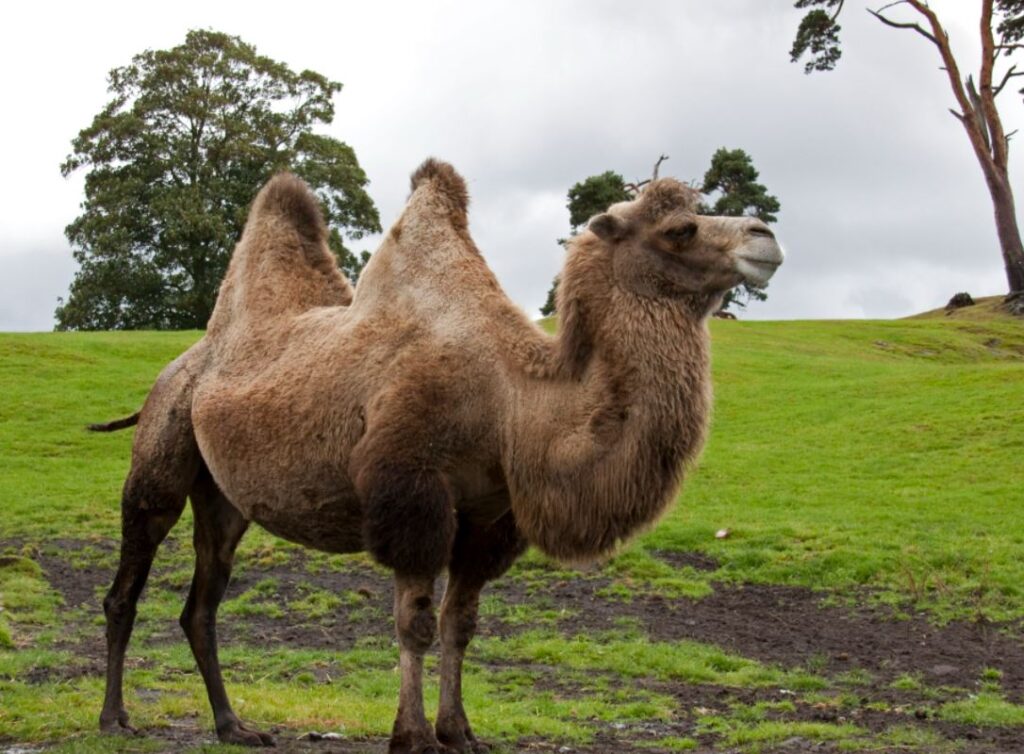Things To Know About Camels
1. There are three species of camel.
The Dromedary or Arabian camel is the most common species, making up 90% of all camels on the planet today. This species is distinct from the others as it has only one hump. The other two species, the Bactrian camel and the Wild Bactrian camel have two humps far less common. The Wild Bactrian camel is considered critically endangered by the IUCN.

2. Camels aren’t just found in Africa and the Middle East.
While you might picture the Sahara desert when you think of camels, these creatures roam in other parts of the globe as well. Bactrian camels are primarily located in the mountains and deserts of China and Mongolia, and feral Dromedary or Arabian camels can be found in central Australia.
3. Camels’ humps don’t store water.
Camels burn the fat in their humps for energy. A byproduct of this process is water, which helps to keep camels hydrated. They store fat, which helps camels survive in the desert, where food and water are often scarce. If they have enough fat stored up, camels can go without water for over a week and without food for four to five months. The fact that camels have all their fat stored in one place also allows them to keep cool better than most animals.
4. Camels’ humps can deflate!
As they use up their fat supply for energy and hydration, camels’ humps will collapse in on themselves. So if you see a camel with a deflated hump, give him a snack! Once camels eat and drink again, their humps reinflate.
5. Camels are herbivores but can be omnivores if necessary.
In case you’re wondering what to feed your new camel friend, here’s some info. Wild camels will eat almost any plant they can find, as long as it is not poisonous. This includes prickly plants like cacti. If vegetation is hard to come by, camels will eat bones, fish, and carrion. Domesticated and captive camels are often fed a mix of grains and hay and sometimes given carrots or apples as a treat.
6. Camels can drink lots of water at once.
A thirsty camel can drink up to 53 gallons (200 liters) in 3 minutes. That’s 882 eight-ounce (~227 milliliters) glasses!
7. A full-grown camel can be over 11 feet long.
Adult Bactrian camels are typically 10-11.5 feet (~3-3.5 meters) long and 5.2-5.9 feet (~1.6-1.8 meters) high from foot to shoulder. They weigh from 990-1,100 pounds (~450-500 kilograms). Adult Dromedary or Arabian camels vary quite a lot in size. They can be anywhere from 7.2-11.2 feet (~2.2-3.4 meters) long and 5.9-6.6 feet (~1.8-2 meters) high from foot to shoulder. Adult Dromedary or Arabian camels weigh from 880-1,320 pounds (~400-600 kilograms).
8. Camels are herd animals.
They travel together in groups called caravans or flocks. These herds typically consist of one male, several females, and they’re young. Single male camels may also form what is known as “bachelor herds” until they can find mates.
9. Camels have a gestation period of 12-14 months.
Camels usually only have one offspring at a time but occasionally give birth to twins. A baby camel can weigh up to 88 pounds (40 kilograms) and walk within 30 minutes of being born!
10. Camels spit to ward off predators or other threats.
When a camel is agitated, it will spit a mix of saliva and partly-digested food at its attacker. This liquid more closely resembles vomit than spit – yuck! Camels may also spit at other herd members to establish dominance or express disinterest in possible mates.
11. Camels communicate in several ways.
Other than spitting, camels have many more pleasant means of getting their point across. Camels can communicate using different ear, head, neck, and tail positions. When a camel puts its ears forward, it means it is alert. When a camel tucks in its tail, it is a sign of submission.
Additionally, camels often grunt and moan at each other or their handlers. Camels can also bleat like sheep and roar like lions! Camels have been known to blow on each other’s faces as a friendly greeting, and newborn camels and their mothers hum to one another.
Questions & Answers:
Question: Are camels faster than horses?
Answer: Camels are slightly slower than horses at top speed. However, camels have more endurance than horses. Camels can run 20-25 miles per hour (~32-40 kilometers per hour), while horses can run 25-30 miles per hour (~40-48 kilometers per hour).
Answer: Yes! Camels and llamas, along with alpacas, guanacos, and vicuñas, make up the Camelidae family. They are all large mammals with long necks, a similar gait, and two toenails on each foot. Camelids are also primarily herbivorous.
Answer: Camels are less closely related to moose than they are to other camelids. Moose are part of the Cervidae family, along with deer and elk. Cervids and camelids belong to the Artiodactyla order, along with many other four-legged herbivores like giraffes, goats, hippos, and pigs.
Question: What is a camel’s taxonomy?
Answer: Kingdom – Animalia, Phylum – Chordata, Class – Mammalia, Order – Artiodactyla, Family – Camelidae, Genus – Camelus
Question: Why can camels eat cacti?
Answer: Camels have papillae (cone-shaped protrusions) inside their mouths that protect them from cacti spikes. Their sharp teeth also help them to soften the plant. Camels pivot their jaws while eating, which guides the cacti down their throats smoothly. In addition, camels have three separate chambers in their stomachs, which helps them break down food. Eating thorny plants like cacti causes camels some discomfort but do not deter them from coming back for more.
Question: Are camels rumiants?
Answer: No, camels are not ruminants. Camels only have three chambers in their stomach, while ruminants like cows, goats, and sheep have four.
Question: Why doesn’t camel milk curdle?
Answer: Camel milk does not curdle because it is 90% water. The structure of camel milk proteins is different from that of cow, goat, or sheep’s milk. Therefore, it does not coagulate in the same way when the pH is lowered. This makes it especially difficult to make cheese out of camel milk.
Question: Is camel milk more nutritious than cow’s milk?
Answer: Yes. Camel milk has less fat and more iron, potassium, and vitamin C than cow’s milk.
Question: How long have camels been domesticated?
Answer: Camels were first domesticated over 3,000 years ago in the Middle East. To this day, they are used as a means of transportation across vast and desolate landscapes. Camels are also bred for their milk, meat, and hair.
Question: How much weight can a camel carry?
Answer: Camels can carry over 200 pounds (~90.7 kilograms) for extended periods without much difficulty.
Question: What is a camel’s native habitat?
Answer: The Dromedary or Arabian camel is believed to be native to the Arabian Peninsula. However, there have been no wild Dromedary or Arabian camels for more than 2,000 years. The Bactrian camel is native to Central Asia.
Question: What’s the difference between wild, domesticated, and feral camels?
Answer: The Wild Bactrian camel is the only extant wild camel species in the world. They are similar to the Bactrian camel but have major genetic differences, meaning they are two distinct species. These wild camels can also drink salt water, domesticated and feral camels cannot, and have longer feet. Central Australia has a larger population of feral Dromedary or Arabian camels. These camels are descendants of domesticated camels imported from India and Afghanistan in the 19th and early 20th centuries. They are the only Dromedary or Arabian camels to exhibit “wild” behavior today.
Question: Why can a camel drink so much water at once?
Answer: Camels have especially elastic blood cells that can expand up to 240% when filled with water. This allows camels to hold a large volume of water and distributes it throughout its body.
Question: Why do camels have long eyelashes?
Answer: Camels have long, double-layered eyelashes to help keep sand and other debris out of their eyes.
Question: What other traits have camels evolved to deal with sand?
Answer: Camels have a special inner eyelid and closeable nostrils that keep sand out. They also have wide, calloused feet that keep them from sinking into the sand.
Question: How many teeth do camels have?
Answer: Camels have 34 teeth.
Question: Do camels sweat?
Answer: Camels can sweat, but only when well-hydrated. Even so, camels produce very little sweat to conserve water.
Question: What are camel urine and dung like?
Answer: Camel urine is very concentrated, and camel dung is very dry, which helps camels to conserve water.
Question: How much fat can be stored in a camel’s hump?
Answer: Up to 79 pounds (36 kilograms) of fat can be stored in a camel’s hump.
Question: Do baby camels have humps?
Answer: No, baby camels do not have humps. Instead, they have a small tuft of hair on their backs where their hump will grow. Baby camels start to grow humps once they begin to eat solid food.
Question: How long do camels nurse?
Answer: Baby camels typically nurse for 10-18 months, but this varies with species and food availability.
Question: When is a camel considered fully grown?
Answer: A camel is fully grown at around seven years of age.
Question: How long do camels live?
Answer: The average lifespan of a camel is 25-30 years.
Question: What are the camel’s natural predators?
Answer: Because most camels are domesticated, they do not have many natural predators other than humans. Bactrian camels are occasionally hunted by wolves, however.
Question: When are camels typically awake?
Answer: Camels are diurnal, meaning they are awake and active during the day.
Question: Are camels dangerous to humans?
Answer: While camels will usually not hurt humans, they can be dangerous because of their size and strength. When upset or mistreated, camels have been known to bite their handlers, resulting in serious injury.
Question: Are camels bad-tempered?
Answer: Not typically. Camels are often thought of as mean and stubborn, but they tend to be patient and mild-mannered in reality. They are dependable desert guides and companions.
Question: Do camels live outside of Africa, Asia, Australia, and the Middle East?
Answer: Camels only live in other parts of the world in captivity or on farms.
Question: When and where did camels originate?
Answer: Camels originated in North America 40-50 million years ago. These first camels were small but evolved over tens of millions of years to become the camel we know today. Ancestors of the modern camel migrated across the Beringia into Eurasia 6.5-7.5 million years ago.
Question: Why did camels develop a hump?
Answer: Camels are thought to have developed their humps during the Ice Age to survive the frigid conditions and lack of vegetation. Now, their humps come in handy as they traverse arid deserts with fluctuating temperatures.
Question: Why is the Wild Bactrian camel critically endangered?
Answer: Wild Bactrian camels have become critically endangered because they are hunted for sport and their meat. They are also killed because they take up food and resources necessary for domesticated camels and other livestock. Additionally, the Wild Bactrian camel population has decreased due to habitat loss. There are only an estimated 650 Wild Bactrian camels in China and 450 in Mongolia.
Question: What is being done to protect the Wild Bactrian camel?
Answer: The Wild Camel Protection Foundation has set up a reserve in the Gobi desert (Northeastern China and Southern Mongolia) to protect Wild Bactrian camels and their habitat.
Question: Which country has the most camels?
Answer: Somalia has the most camels in the world. Camels are an essential part of the nomadic lifestyle of many Somalis as they provide transportation, milk, meat, and hair for clothing and textiles.
Question: How many camels are there worldwide?
Answer: As of 2010, there were an estimated 14 million camels worldwide. 90% of all camels are Dromedary or Arabian, and most are domesticated.

